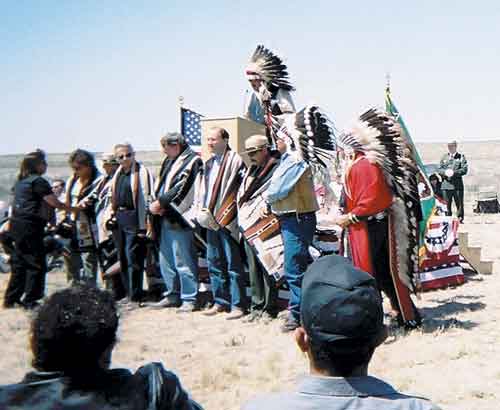January 25, 2008 by: Bobbie Whitehead / Indian Country Today
To support the tribe's plans, the Northern Cheyenne needs additional funding and is accepting donations to help with its Sand Creek programs.
''We are contemplating acquiring some land there that could come up for sale,'' said Steve Brady, Northern Cheyenne and co-chair of the Sand Creek Massacre National Historic Site Committee for the Northern Cheyenne Indian Nation. ''We're working toward that end.''
Currently, the majority of the 12,300-acre Sand Creek Massacre National Historic Site is privately owned.
But the National Park Service as well as the Cheyenne-Arapaho Tribes of Oklahoma has acquired about 3,000 acres of the site, with the 1,465 acres acquired by the Cheyenne-Arapaho Tribes of Oklahoma placed in a federal trust in 2005 for management as part of the national historic site, according to Brady.
''We're fortunate that all of this land is contiguous,'' Brady said.
Along with trying to acquire some of the Sand Creek land, the Northern Cheyenne, Northern Arapaho and the Cheyenne-Arapaho Tribes of Oklahoma want to repatriate human remains associated with the massacre and create a memorial there, Brady said.
''The tribes have the custody of those remains,'' Brady said. ''They will be interned at the Sand Creek massacre site when the site is ready, and the tribes, the National Park Service, the state of Colorado and the descendants of the victims of the massacre will establish the memorial.''
While purchasing the land and repatriating remains stand out as significant aspects to the Northern Cheyenne's Sand Creek program, the tribe also has begun an educational program that targets younger members of the tribe who know less about the Sand Creek Massacre and tribal history, said Otto Braided Hair, coordinator of the Sand Creek Massacre National Historic Site Committee for the Northern Cheyenne.
''What's been happening with our people in school is the youth almost always find the tribal history left [out],'' Braided Hair said. ''A lot of our youth aren't aware of their history. We'd like for them to know that in the West and on the Plains, the Cheyenne was one of the dominant tribes.''
Braided Hair points out that the Sand Creek Massacre project will also provide activities for other tribal members as well as educate the public.
''The Sand Creek Massacre remains an open wound for the Indian people, Colorado history and U.S. history,'' he said. ''The tribe is in need of funds to continue these programs.''
Site background
After going through three acts of Congress to establish a historic site where Arapaho and Cheyenne Indians were massacred by U.S. militia in Colorado in 1864, the tribes along with the state of Colorado and the National Park Service dedicated the Sand Creek Massacre National Historic Site in April 2007.
As a National Park Service location, the site serves to honor those Indians who died there and those who survived, according to Brady.
The Cheyenne Arapaho Treaty of Little Arkansas in 1865, in which Congress condemned atrocities that included the slaughter of women and children as well as the murder of Chief Black Kettle of the Cheyenne - who had held up a U.S. flag when the soldiers approached - promised reparations to the Arapahos and Cheyennes, Brady said.
While the tribes have worked for years to protect and acquire the Sand Creek site, Brady said in March 1998, former Colorado Sen. Ben Nighthorse Campbell introduced a bill for the tribes to acquire the Dawson property, which was the property in southeastern Colorado believed to be the site of the Sand Creek Massacre.
Some questions about the specific Sand Creek Massacre site arose; and President Bill Clinton in October 1998 signed the Sand Creek Massacre Study Act, which was created to determine where the massacre took place, he said.
''They were lacking evidence at that time,'' Brady said.
To determine the actual location, the National Park Service went out to the Dawson property to study it and look for artifacts. Its study spanned 18 months during 1999 - 2000.
''They had been out there in 1997, but they found too few artifacts,'' Brady said.
But after officials went farther north in 1999, they found well over 300 artifacts. One of the artifacts found was a cannonball, Brady said.
''The Sand Creek Massacre was the only time the U.S. military had used artillery against an Indian encampment,'' he said.
With the finding of the cannonball, Brady said officials realized they had found the massacre site.
In 2000, Campbell introduced another bill to Congress; and Clinton signed the Sand Creek Massacre National Historic Site Establishment Act that year, Brady said.
''This federal law designated 12,300 acres as the site, but provisions said land would only be acquired by a willing seller only,'' he said.
Since then, the National Park Service and the Cheyenne-Arapaho Tribes of Oklahoma have been able to acquire some of the Sand Creek property; and with land coming available, the Northern Cheyenne plan to acquire some of the site but need funds to do so, Brady said.
Donations to the Northern Cheyenne for its Sand Creek Massacre National Historic Site project can be mailed to P.O. Box 128, Lame Deer, MT 59043 (checks should be made payable to the Northern Cheyenne Tribe). For more information, call the tribe's main office at (406) 477-6284.
© 1998 - 2008 Indian Country Today. All Rights Reserved
To subscribe or visit go to: http://www.indiancountry.com
